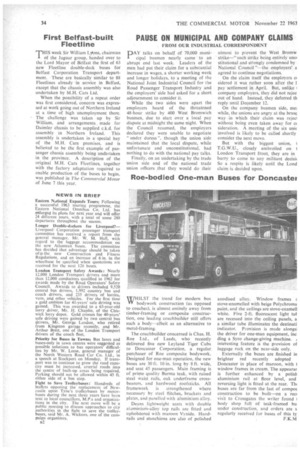PAUSE ON MUNICIPAL AND COMPANY CLAIMS
Page 36

If you've noticed an error in this article please click here to report it so we can fix it.
FROM OUR INDUSTRIAL CORRESPONDENT
PAY talks on behalf of 70,000 municipal busmen nearly came to an abrupt end last week. Leaders of the men had put their claim for a substantial increase in wages, a shorter working week and longer holidays, to a meeting of the National Joint Industrial Council for the Road Passenger Transport Industry and the employers' side had asked for a short adjournment to consider it.
While the two sides were apart the employers heard of the threatened 48-hour strike by 400 West Bromwich busmen, due to start over a local pay dispute at midnight the same night. When the Council resumed, the employers declared they were unable to negotiate "under duress ", though the union side maintained that the local dispute, while unfortunate and unconstitutional, had nothing to do with the national pay talks.
Finally, on an undertaking by the trade union side and of the national trade union officers that they would do their
VVHILST the trend for modern bus bodywork construction (as opposed to coaches). is almost entirely away from timber-framing or composite construction, one leading coachbuilder still offers such a body—albeit as an alternative to metal-framing.
The coachbuilder concerned is Chas. H. Roe Ltd., of Leeds, who recently delivered five new Leyland Tiger Cubs to Doncaster Corporation, a regular purchaser of Roe composite bodywork. Designed for one-man operation, the new buses are 30 ft. 10 in. long by 8 ft. wide, and seat 45 passengers. Main framing is of prime quality Burma teak, with raised steel waist rails, oak underframe crossbearers, and hardwood roofsticks. All framework is strengthened where necessary by steel flitches, brackets and plates, and panelled with aluminium alloy.
Deans .lightweight seats with double aiuminium-alloy top rails are fitted and upholstered with maroon Vynide. Handrails and stanchions are also of polished utmost to prevent the West Bromw strike—"-such strike being entirely unci stitutional and strongly condemned by National Council "—the employers' s agreed to continue negotiations.
On the claim itself the employers CI sidered it was rather soon after the I pay settlement in April. But, unlike company employers, they did not rejec out of hand. Instead, they deferred th reply until December 12.
On the company busmen side, me: while, the unions are angry at the brusq way in which their claim was rejeci without being even taken away for et sideration. A meeting of the six unit involved is likely to be called shortly consider the next move.
But with the biggest union, 1 T.G.W.U., closely embroiled on 1 London Transport front, they are in hurry to come to any militant decisii So a respite is likely until the Lond claim is decided upon.
anodised alloy. Window frames t stove-enamelled with beige Polychroma paint, and the ceilings are stove-enamell white. Five 2-ft. fluorescent light tut are recessed into the ceiling panels, a a similar tube illuminates the destinati indicator. Provision is made along& the driver for one-man equipment, inc ding a Syro change-giving machine. interesting feature is the provision of luggage rack on the near-side only.
Externally the buses are finished in brighter red recently adopted Doncaster in place of maroon, with I window frames in cream. The appearar is further enhanced by a polish aluminium rail at floor level, and reversing light is fitted at the rear. Thi buses are far from the last of compos construction to be built—on a reel visit to Crossgates the writer found body shop full of teak-framed bu under construction, and orders are s regularly received for buses of this ty
F.K.M




































































































